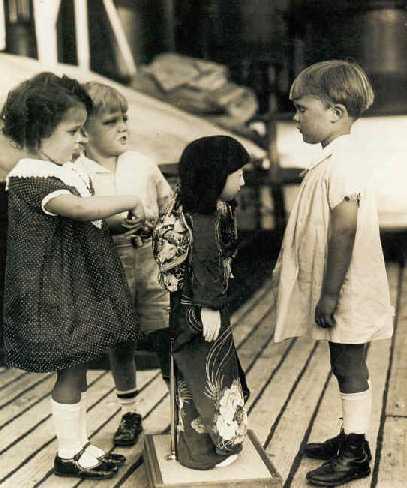|
It is my sincere honor to welcome Consul General of Japan and Mrs. Abe; Mr. Randy Withrow, Chief of Staff for the Mayor of Spokane; Mr. Bruce Eldredge, Chief Executive Officer, Northwest Museum of Arts & Culture; Mr. and Mrs. Takuya Kobayashi, Assistant Director, Hyogo Business and Cultural Center; Ms. Barbara Richardson from the Board of Directors, School District 81; Mr. and Mrs. John Talbot, former Mayor of Spokane; dear school children, ladies and gentlemen. I am very much impressed to see so many smiling faces and so many dolls in this hall! A special feeling of friendship fills this room. My special thanks to Mr. Griffith and his students for telling the Friendship Doll story in such a wonderful way. The Doll Festival, Hina Matsuri, has more than 1,000 years of history of giving the message for young girls' happiness. Hina means chick, a newly born bird, a tiny thing or a cute creature. Originating as a family tradition, Hina dolls are displayed in homes and are handed down from mother to daughter for generations. These days, Hina doll sets like the one displayed here are also displayed at schools, hotels, department stores, and everywhere in Japan during the month of March. After being displayed for one month, Hina dolls are put back into boxes and are stored. The symbol of Hina Matsuri is peach flowers. Hina dolls are the reminders of family history, of grandma, grandpa, of mother's cooking, happy childhood and of friends. Additionally in Japan, March is the time of change: graduations are held in March and a new school year begins in April. Springtime is the season of growth and new beginnings. Hina dolls send these feelings to the Japanese. Now let me introduce you to Miss Tokushima, a very quiet smiling lady. She was born in Tokyo in 1927. She is 76 years old. She looks so young for her age. She is not only a display doll, she can also bend her arms and legs. She can even sit in a Japanese way. She also has a small voice box in her body like America mama dolls! It was early in 1992 when I saw my first Torei (Thank You) doll, Miss Tokushima, at the then Cheney Cowles Museum. She was in her travel trunk you see beside her on stage. Her mouth was half open, and she looked as if she had so much in her mind to tell me. Right away, I decided to have a doll festival with her in Spokane. First, I wanted to thank the Spokane community for the long care and protection of her. Second, I wanted to share this story with our students and the American people, especially with children. We celebrated the first Doll Festival on March 3, 1992, at Cheney Cowles Museum. Since then every year Miss Tokushima has been attending the Doll Festivals in the spring and the Culture Day celebrations in the fall, meeting over 7,000 American and Japanese people. She is one of the busiest doll Ambassadors in the U.S. Mukogawa started sending Japanese Friendship Dolls to American schools and educational institutions in 1993, and, now, 476 schools and educational institutions in all 50 states and Washington, D.C., have recipients.
Today, I would like to introduce to you two stories on how the Friendship Dolls were received by children. At right is a photo of Miss Tottori with children in South Dakota. The American children were interested in Miss Tottori's black eyes, black hair, strange dress, long sleeves, and bulky belt. Everything was a target of their curiosity. Most of the remaining Japanese dolls have dirty hands and stained cheeks because the American children shook their hands, hugged and kissed them. The dolls were much loved. Another story comes from Alabama and the May 18, 1967, edition of The Birmingham Post-Herald. Miss Iwate from northern Japan had been kept in Birmingham Public Library and was on exhibit during the '67 Festival of Arts. On the front page, we see three photos taken in sequence. The caption read, "GETTING TO KNOW YOU - A formal introduction wasn't needed for Miss Iwate and 4-year-old Birmingham lass Kelley Jackson at the Public Library yesterday. It was love at first sight for the Japanese doll sent in 1928 by children of Iwate-ken, Japan, as a friendship gesture to Birmingham children." The article also introduced a translated letter of a Japanese girl from Iwate: "The doll you sent us (an American doll in Japan) has a sad lonesome look on her so beautiful face, because she had to cross big water, and we cannot understand her language coming from a different country. But everyone talks lovingly to this doll, each of us hug the doll and sing for her. She looks too cold, so we put on her some more clothes and once in a while some perfume. Now she begins to look like she loves us too." Friendship Dolls convey the dreams and messages from millions who have sent letters, made clothes, or protected the dolls. Today, we are again part of Dr. Sidney Gulick's noble vision. His wish was that peace be written in the hearts of children. One person makes a difference. Dr. Gulick first showed this fantastic path. Now it is up to us, my friends, to broaden this path for peace and friendship in the world. Please join us in this noble project. The Japanese Cultural Center Phone: 509-328-2971 |
Speech given at Doll Festival celebrated at MFWI on March 3, 2002
Photo used with permission of Yokohama Doll Museum
